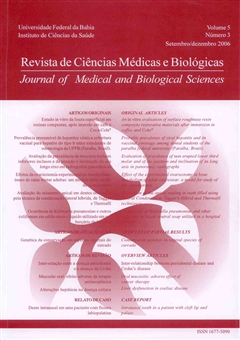An in vitro evaluation of surface roughness resin composite restorative materials after immersion in coffee and Coke®
DOI:
https://doi.org/10.9771/cmbio.v5i3.4128Keywords:
Aesthetic materials, elementary particles, composite resin.Abstract
The purpose of this study was to evaluate the alteration of roughness of aesthetic restoratives materials in the shade A1: Esthet X® (microfill), Herculite® (microhybrid) and Durafil® . Thirty six disk-shaped specimens were manipulated, and polimerized according to the manufacturers instructions to each resin. After curing the specimens were immersed in artificial saliva at 37ºC and stored for one week. The samples were divided in four groups, and underwent three cycles per day for thirty days immersed into artificial saliva, coffee, Coke® and coffee followed by Coke®. The samples were stored into artificial saliva, in bacteriologic stove, in the 37oC (±1oC). All the groups were stored into artificial saliva in the interval of the cycles and the control group was stored into artificial saliva all time. After thirty days, the rougness was measure by perfilometer (MITUTOIO®) and the data was analized with a one-way analysis of variance (ANOVA), and nean values were compared by the Tukey TSD test. Based on of these data, we can conclude that: The immersion into Coke® and into coffee followed by Coke® decreased the roughness surface in all resins and the immersion into coffee increase the roughness surface in Durafil® and Esthet X®.Downloads
Download data is not yet available.
Downloads
Published
2006-02-04
How to Cite
Figueredo, C. M. S., Sampaio Filho, H. R., & Paes, P. N. G. (2006). An in vitro evaluation of surface roughness resin composite restorative materials after immersion in coffee and Coke®. Journal of Medical and Biological Sciences, 5(3), 207–213. https://doi.org/10.9771/cmbio.v5i3.4128
Issue
Section
ORIGINAL ARTICLES
License
The Journal of Medical and Biological Sciences reserves all copyrights of published works, including translations, allowing, however, their subsequent reproduction as transcription, with proper citation of source, through the Creative Commons license. The periodical has free and free access.


